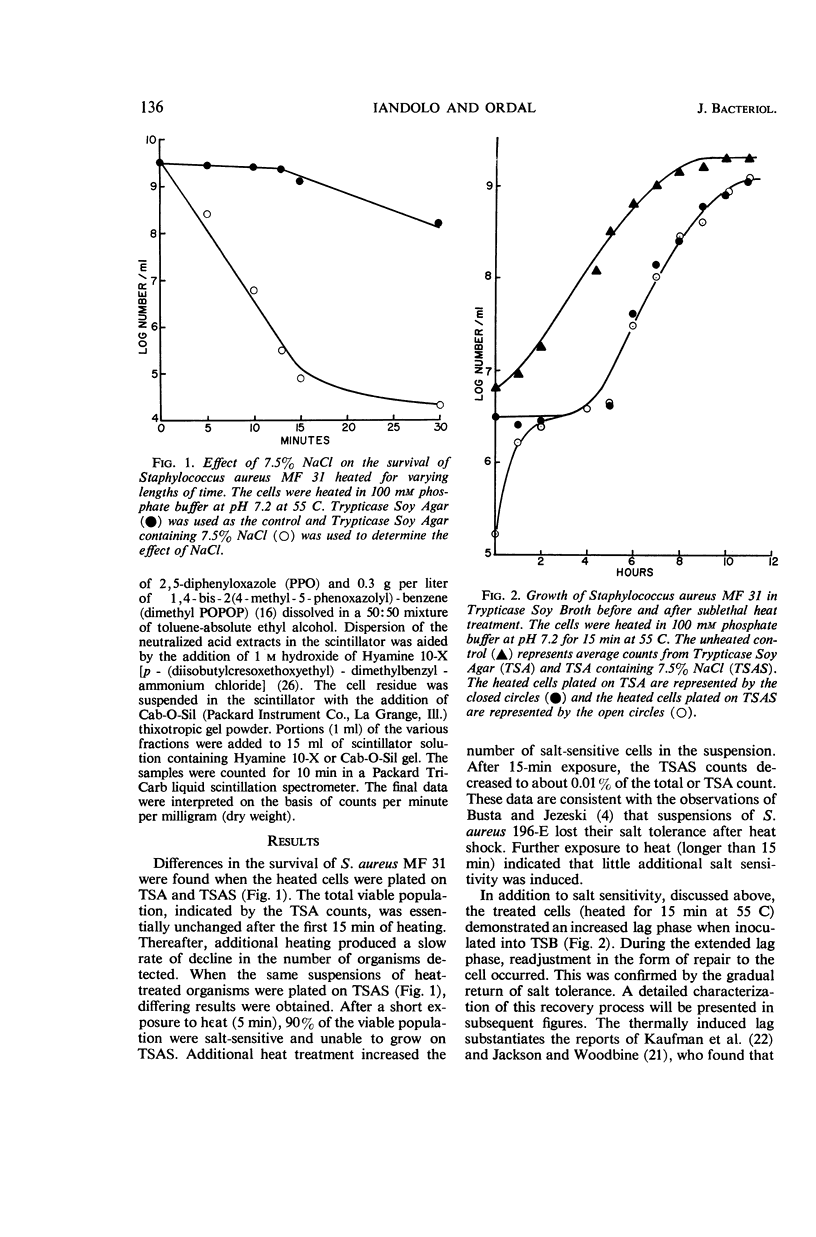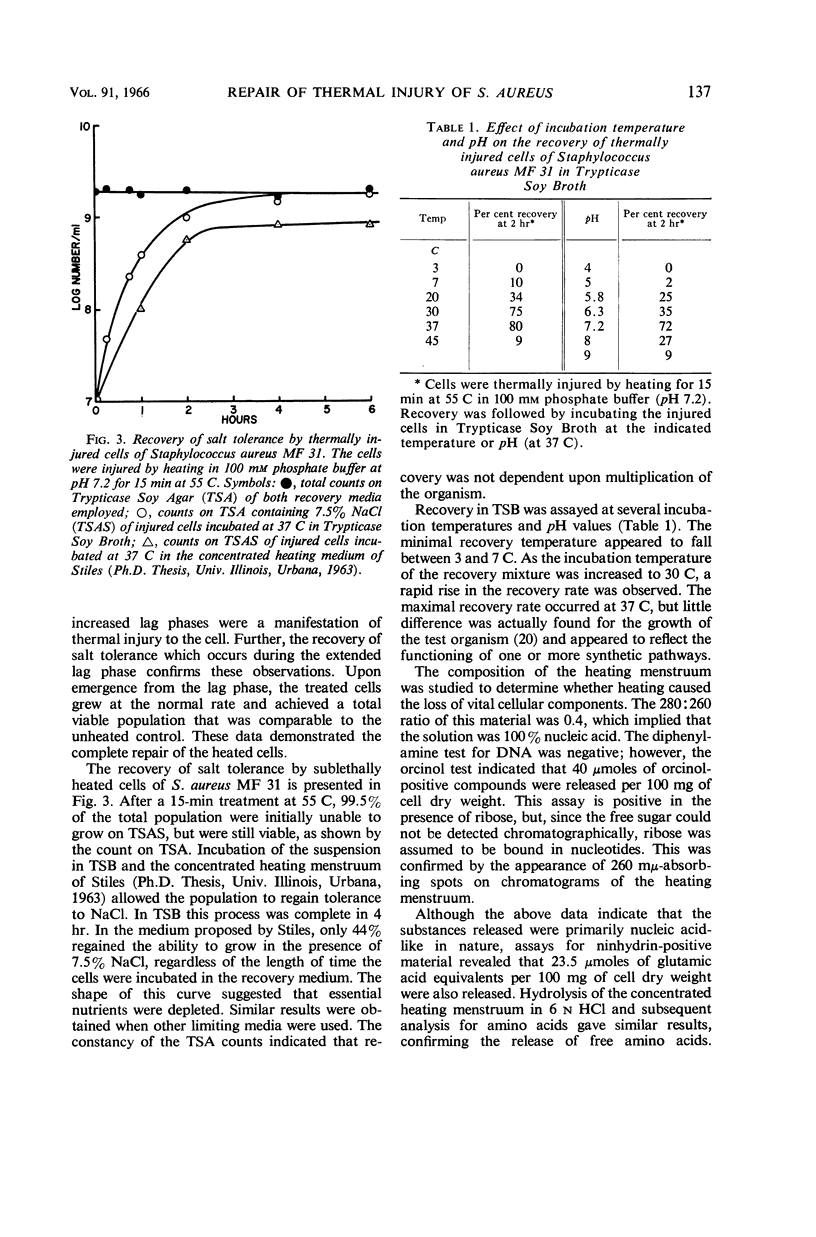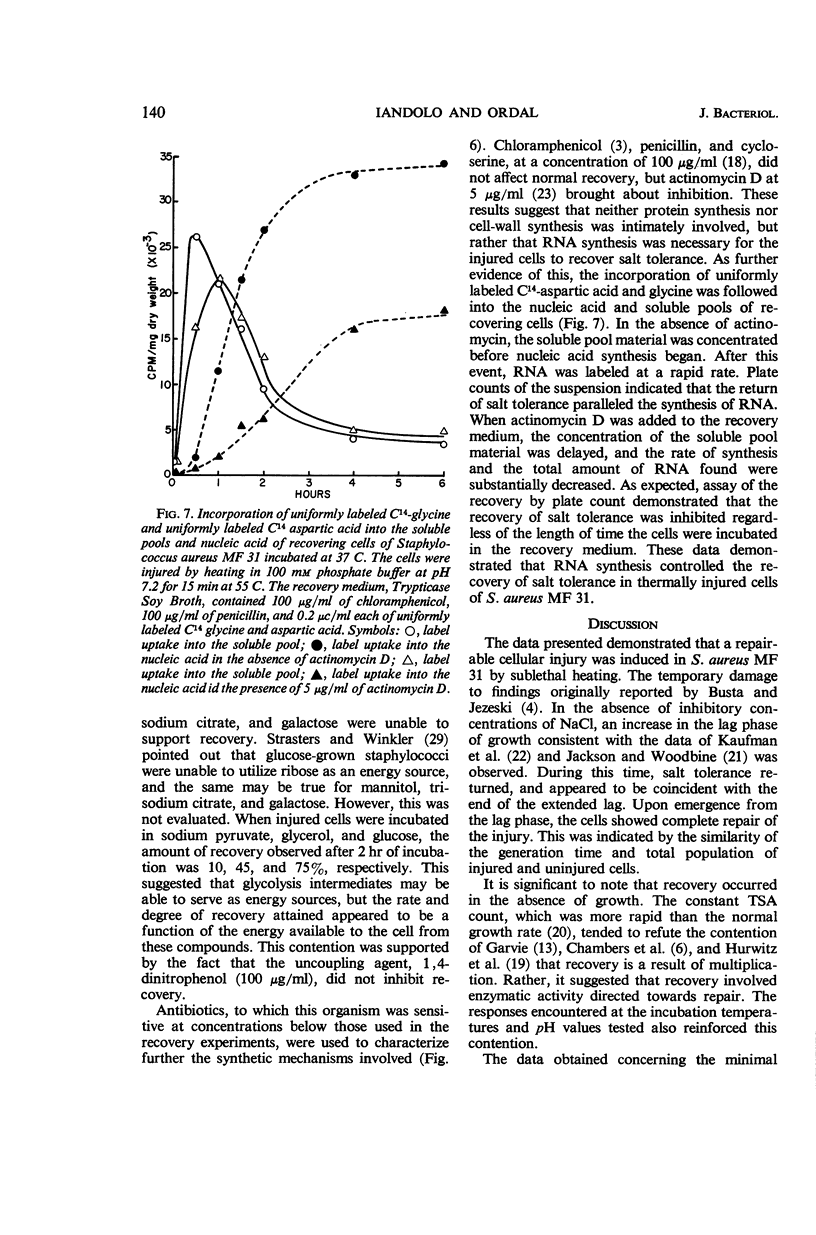Abstract
Iandolo, John J. (University of Illinois, Urbana), and Z. John Ordal. Repair of thermal injury of Staphylococcus aureus. J. Bacteriol. 91:134–142. 1966.—Exposure of Staphylococcus aureus MF 31 to sublethal temperatures produced a temporary change in the salt tolerance and growth of the organism. After sublethal heat treatment at 55 C for 15 min, more than 99% of the viable population was unable to reproduce on media containing 7.5% NaCl. The data presented demonstrate that thermal injury, in part, occurred owing to changes in the cell membrane, which allowed soluble cellular components to leak into the heating menstruum. When the cells were placed in a limiting medium, complete recovery did not occur, regardless of the incubation time. The temperature and the pH which produced the optimal rate of recovery were similar to those described previously for the multiplication of uninjured cells. However, the rate of recovery as well as the unchanging total count during recovery indicated that cell multiplication was not a factor during the recovery process. The nutrient requirements for the complete recovery of injured cells consisted of a solution containing an energy source, such as glucose, a mixture of amino acids, and phosphate. The use of the metabolic inhibitors, penicillin, cycloserine, 2,4-dinitrophenol, and chloramphenicol, did not inhibit recovery. Actinomycin D, however, completely suppressed recovery. This result implied that ribonucleic acid synthesis was particularly involved; this inference was substantiated by radio tracer experiments. The rate at which label was incorporated in the nucleic acid fraction paralleled that of recovery and the return of salt tolerance.
Full text
PDF








Selected References
These references are in PubMed. This may not be the complete list of references from this article.
- BUSTA F. F., JEZESKI J. J. EFFECT OF SODIUM CHLORIDE CONCENTRATION IN AN AGAR MEDIUM ON GROWTH OF HEAT-SHOCKED STAPHYLOCOCCUS AUREUS. Appl Microbiol. 1963 Sep;11:404–407. doi: 10.1128/am.11.5.404-407.1963. [DOI] [PMC free article] [PubMed] [Google Scholar]
- Brock T. D. CHLORAMPHENICOL. Bacteriol Rev. 1961 Mar;25(1):32–48. doi: 10.1128/br.25.1.32-48.1961. [DOI] [PMC free article] [PubMed] [Google Scholar]
- CALIFANO L. Libération d'acide nucléique par les cellules bactériennes sous l'action de la chaleur. Bull World Health Organ. 1952;6(1-2):19–34. [PMC free article] [PubMed] [Google Scholar]
- CHAMBERS C. W., TABAK H. H., KABLER P. W. Effect of Krebs cycle metabolites on the viability of Escherichia coli treated with heat and chlorine. J Bacteriol. 1957 Jan;73(1):77–84. doi: 10.1128/jb.73.1.77-84.1957. [DOI] [PMC free article] [PubMed] [Google Scholar]
- CHRISTIAN J. H., WALTHO J. A. Solute concentrations within cells of halophilic and non-halophilic bacteria. Biochim Biophys Acta. 1962 Dec 17;65:506–508. doi: 10.1016/0006-3002(62)90453-5. [DOI] [PubMed] [Google Scholar]
- EIGNER J., BOEDTKER H., MICHAELS G. The thermal degradation of nucleic acids. Biochim Biophys Acta. 1961 Jul 22;51:165–168. doi: 10.1016/0006-3002(61)91028-9. [DOI] [PubMed] [Google Scholar]
- GALE E. F., FOLKES J. P. The assimilation of amino-acids by bacteria. XV. Actions of antibiotics on nucleic acid and protein synthesis in Staphylococcus aureus. Biochem J. 1953 Feb;53(3):493–498. doi: 10.1042/bj0530493. [DOI] [PMC free article] [PubMed] [Google Scholar]
- GALE E. F. The assimilation of amino-acids by bacteria; action of inhibitors on the accumulation of free glutamic acid in Staphylococcus aureus and Streptococcus faecalis. Biochem J. 1951 Mar;48(3):286–290. doi: 10.1042/bj0480286. [DOI] [PMC free article] [PubMed] [Google Scholar]
- GARVIE E. I. The growth of Escherichia coli in buffer substrate and distilled water. J Bacteriol. 1955 Apr;69(4):393–398. doi: 10.1128/jb.69.4.393-398.1955. [DOI] [PMC free article] [PubMed] [Google Scholar]
- HANCOCK R. The intracellular amino acids of Staphylococcus aureus: release and analysis. Biochim Biophys Acta. 1958 May;28(2):402–412. doi: 10.1016/0006-3002(58)90488-8. [DOI] [PubMed] [Google Scholar]
- HEIMETS F., TAYLOR W. W., LEHMAN J. J. The use of metabolites in the restoration of the viability of heat and chemically inactivated Escherichia coli. J Bacteriol. 1954 Jan;67(1):5–12. doi: 10.1128/jb.67.1.5-12.1954. [DOI] [PMC free article] [PubMed] [Google Scholar]
- HURWITZ C., ROSANO C. L., BLATTBERG B. A test of the validity of reactivation of bacteria. J Bacteriol. 1957 Jun;73(6):743–746. doi: 10.1128/jb.73.6.743-746.1957. [DOI] [PMC free article] [PubMed] [Google Scholar]
- IANDOLO J. J., ORDAL Z. J., WITTER L. D. THE EFFECT OF INCUBATION TEMPERATURE AND CONTROLLED PH ON THE GROWTH OF STAPHYLOCOCCUS AUREUS MF 31 AT VARIOUS CONCENTRATIONS OF NACL. Can J Microbiol. 1964 Oct;10:808–811. doi: 10.1139/m64-104. [DOI] [PubMed] [Google Scholar]
- KAUFMANN O. W., HARMON L. G., PAIL THORP O. C., PFLUG I. J. Effect of heat treatment on the growth of surviving cells. J Bacteriol. 1959 Dec;78:834–838. doi: 10.1128/jb.78.6.834-838.1959. [DOI] [PMC free article] [PubMed] [Google Scholar]
- KIRK J. M. The mode of action of actinomycin D. Biochim Biophys Acta. 1960 Jul 29;42:167–169. doi: 10.1016/0006-3002(60)90769-1. [DOI] [PubMed] [Google Scholar]
- STILES M. E., WITTER L. D. THERMAL INACTIVATION, HEAT INJURY, AND RECOVERY OF STAPHYLOCOCCUS AUREUS. J Dairy Sci. 1965 Jun;48:677–681. doi: 10.3168/jds.s0022-0302(65)88321-7. [DOI] [PubMed] [Google Scholar]
- STRANGE R. E., SHON M. EFFECTS OF THERMAL STRESS ON VIABILITY AND RIBONUCLEIC ACID OF AEROBACTER AEROGENES IN AQUEOUS SUSPENSION. J Gen Microbiol. 1964 Jan;34:99–114. doi: 10.1099/00221287-34-1-99. [DOI] [PubMed] [Google Scholar]
- STRASTERS K. C., WINKLER K. C. CARBOHYDRATE METABOLISM OF STAPHYLOCOCCUS AUREUS. J Gen Microbiol. 1963 Nov;33:213–229. doi: 10.1099/00221287-33-2-213. [DOI] [PubMed] [Google Scholar]


